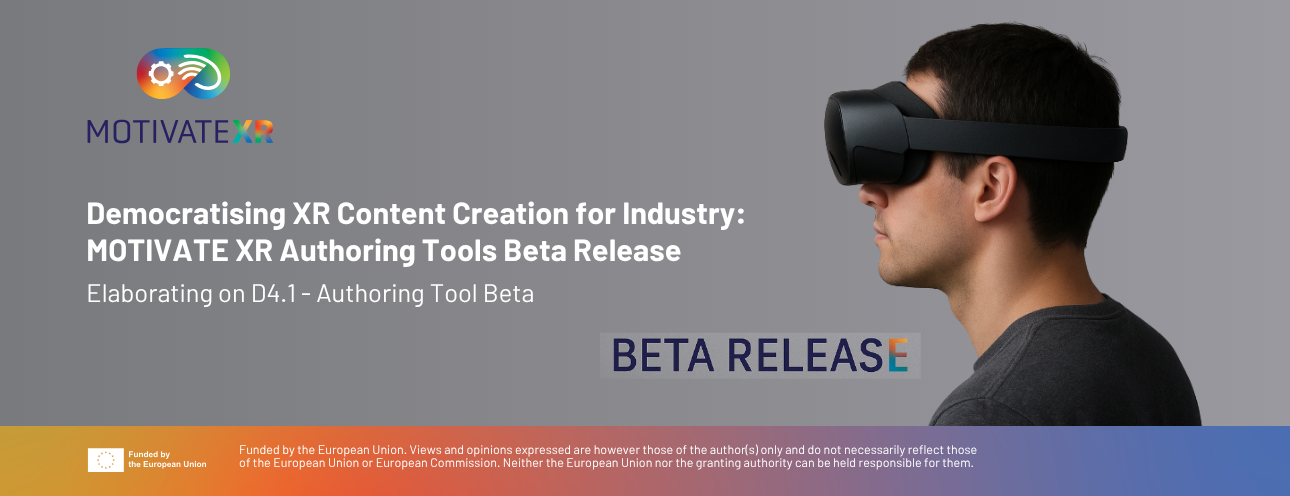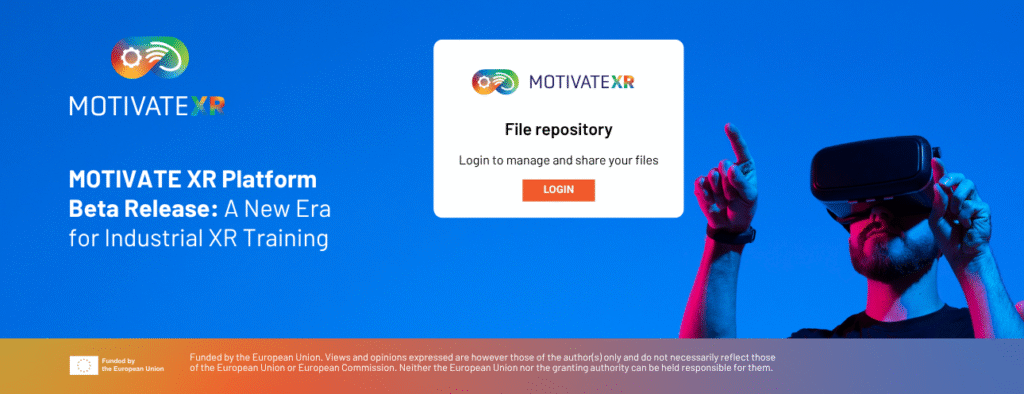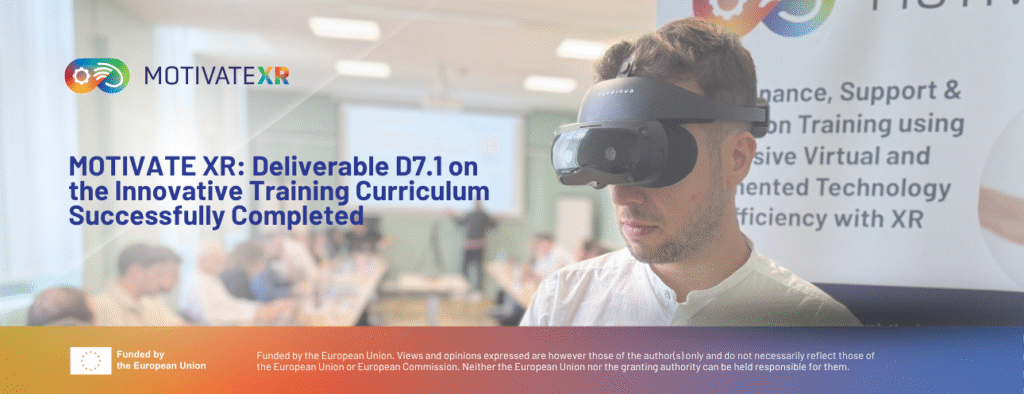Extended Reality (XR) technologies are rapidly transforming industrial training and operational support. Yet, despite their potential, XR solutions often remain inaccessible to many organisations due to technical complexity, high development costs, and the need for specialised expertise. The MOTIVATE XR project, funded by the European Union, aims to overcome these barriers by delivering a modular, interoperable, and user-friendly XR platform tailored for industrial use. The MOTIVATE XR Project is split in two phases, the Beta Release being the first one, and the Final Release being the complete finalised version.
Deliverable D4.1, titled Authoring Tools Beta, presents a significant milestone in this journey. It introduces a suite of tools and services that enable users – from engineers and instructors to non-technical staff – to collaboratively create immersive XR experiences. These tools are designed to simplify the authoring process, integrate AI-powered automation, and support a wide range of industrial applications. This blog post explores the key innovations through achievements of the MOTIVATE XR Authoring Tools Beta.
A New Paradigm for XR Authoring
The MOTIVATE XR platform is built around three core phases: authoring, sharing, and experiencing (see Figure 1). The authoring phase, which is the focus of this deliverable, empowers users to create XR content using existing digital assets such as 3D models, CAD files, and technical documentation. The platform’s no-code approach ensures that even users without programming skills can participate in the creation of immersive training scenarios.
At the heart of the authoring ecosystem are several complementary tools. These include Inscape VTS Editor, KAYROX, and the Narrative Editor – each tailored to different use cases and user profiles. Together, they form a robust and flexible environment for XR content creation.
Inscape VTS Editor, developed by CS GROUP, is a powerful desktop tool built on Unreal Engine 5. It offers an interface for creating training scenarios, supports collaborative editing, and integrates AI assistance to streamline content generation. KAYROX, developed by Tecnalia, is a web-based platform that enables on-site and on-device authoring, allowing users to create and edit XR content directly within XR headsets. This feature is particularly valuable for field operations, where real-time adjustments are essential. The Narrative Editor, created by D-Cube, is designed for step-by-step training in industrial contexts. It allows users to build structured scenarios using multimedia inputs and is currently being used in the aluminium industry pilot.
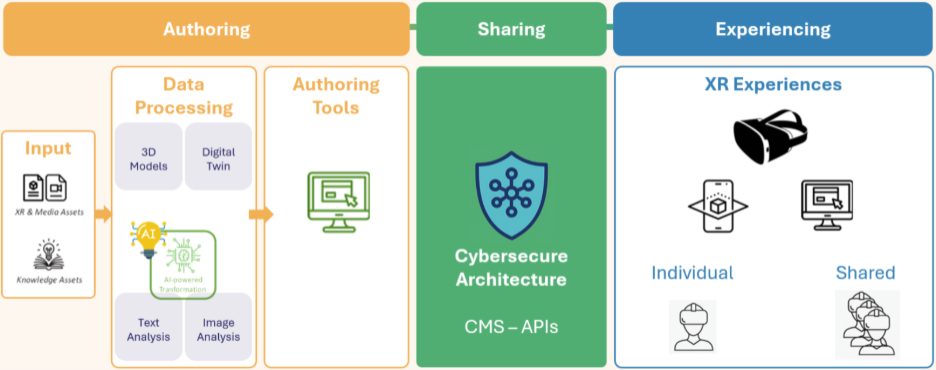
Figure 1: MOTIVATE XR Workflow
Integrating AI for Smarter Authoring
One of the most innovative aspects of the MOTIVATE XR Authoring Tools Beta is the integration of AI-powered services. These services automate key tasks in the content creation process, reducing the need for manual input and accelerating development.
The Semantic Textual Engine (STE) and Semantic Graphical Engine (SGE) are central to this effort. Developed by SOPRA STERIA and UPM respectively, these engines transform static documentation into dynamic, semantically rich knowledge graphs (see Figure 2). The STE processes textual content, extracting entities, procedures, and relationships, while the SGE analyses graphical elements such as diagrams and tables. Together, they enable the automatic generation of training scenarios based on existing manuals and schematics.
These AI modules are tightly integrated with the authoring tools. For example, Inscape VTS Editor can query the Semantic Processing Engine (SPE) – that manages both text and graphics – and retrieve procedural steps for a specific subsystem, receiving structured outputs that populate the scenario graph (see Figure 3).
This interaction is facilitated through an API, allowing seamless communication between the editor and the AI backend.
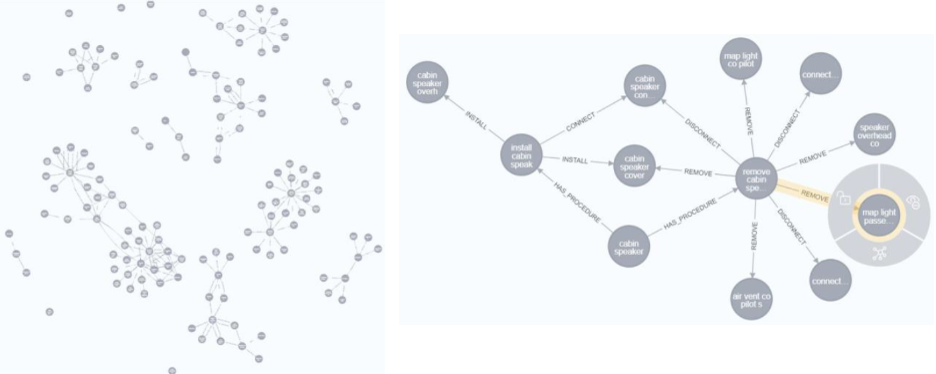
Figure 2: Examples of Knowledge Graphs
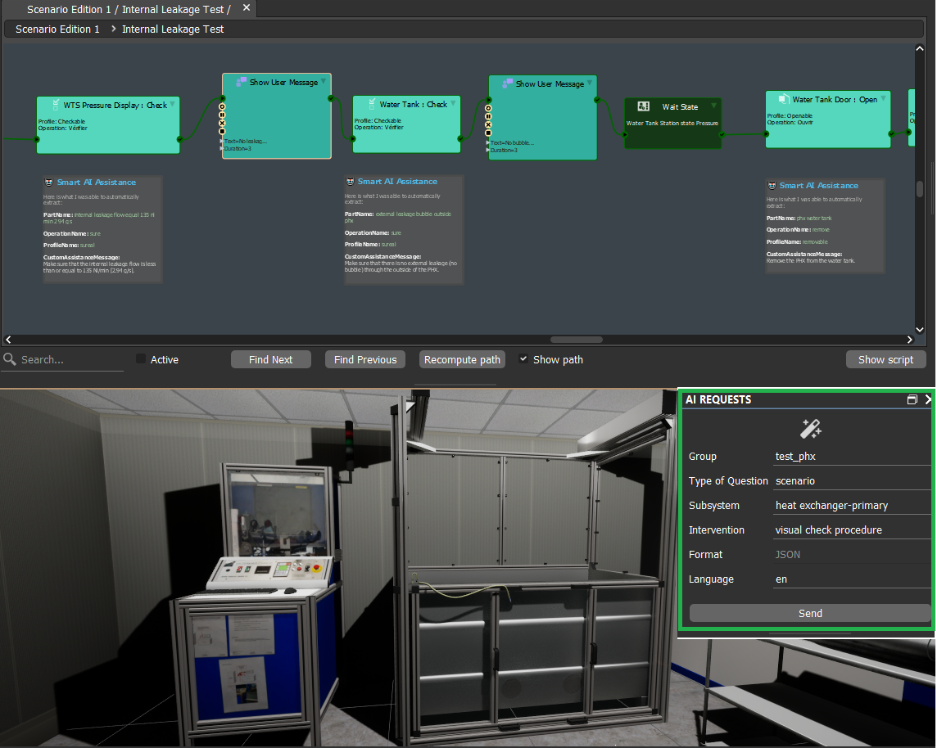
Figure 3: AI assisted authoring, training procedure generation from Knowledge Graphs
3D Scanning and Digital Twin Modelling
Creating realistic XR experiences requires high-quality 3D assets. To address this need, the MOTIVATE XR platform includes advanced 3D scanning and digital twin modelling capabilities.
2Freedom’s SLAM scanner and Video modelling app allow users to generate 3D models from video and image data. These models are processed in the cloud and returned in formats optimised for XR use, such as .ply, .obj, and .glb. The system supports volumetric reconstruction methods like Neural Radiance Fields (NeRFs) and 3D Gaussian Splatting, which enhance visual fidelity and reduce artifacts in complex environments.
Segmentation features are also under development, enabling users to isolate specific components within a scene. These capabilities are essential for creating interactive and context-aware XR content.
On the digital twin side, MIRA, developed by Maggioli, provides a web-based platform for modelling assets and integrating IoT data. Users can create digital representations of physical objects, assign telemetry data, and visualise real-time information within XR scenarios. The integration between MIRA and the authoring tools allows for dynamic content creation based on live sensor inputs.
Enhancing Collaboration and Interoperability
Collaboration is a key focus of the MOTIVATE XR platform. The authoring tools support multi-user editing, version control, and centralised content management.
Interoperability between tools is also being actively considered. Early work on a shared data format based on standards, aims to enable content exchange in particular between Inscape VTS and KAYROX. This will allow users to benefit from the complementarity of the tools and ensuring consistency across platforms.
The platform’s centralised Content Management System (CMS) will further support collaboration by providing scenario storage, tagging, and automated deployment to XR players.
Real-World Applications and Pilots
The Authoring Tools Beta Release is already being tested for several industrial pilots.
In the aeronautics sector for example, Inscape VTS Editor is used to create training scenarios based on aircraft maintenance manuals using AI services.
In the aluminium industry, the Narrative Editor is used to transform fabrication manuals into immersive training modules. The tool’s support for PDF integration and animation editing allows domain experts to create detailed, step-by-step scenarios without coding.
KAYROX is being used in pilots for field operations, such as Human-Robot Hybrid Manufacturing, where its on-device authoring capabilities (see Figure 4) enable real-time adjustments and content creation directly within XR headsets. The tool also supports digital twin data visualisation, allowing users to embed sensor data into XR experiences.
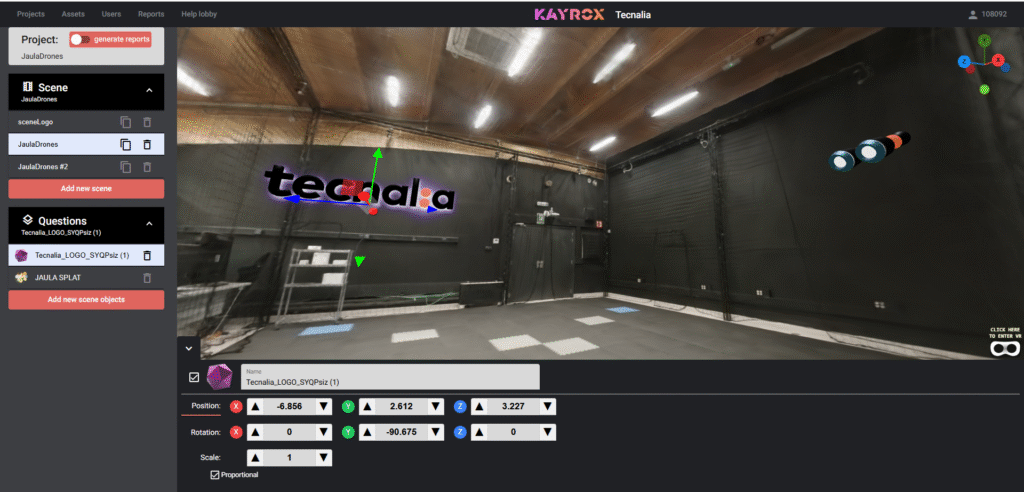
Figure 4 : KAYROX VR – 3D Gaussian Splatting (3DGS) based – experiences web authoring
Looking Ahead: Toward the Final Version
The Beta Version of the MOTIVATE XR Authoring Tools lays a strong foundation for the final release. The next development phase will focus on several key areas:
First, the AI pipelines will be enhanced to support more adaptive prompting, richer semantic extraction, and natural language interaction. This will make the authoring process even more intuitive and accessible.
Second, interoperability between tools will be strengthened to enable efficiently seamless content transfer and synchronisation across authoring environments.
Third, the integration of all authoring tools into the MOTIVATE XR platform will be completed, with further support for centralised content management, multi-author collaboration, and scalable deployment.
Additional features such as live editing, conversational AI assistants, and real-time digital twin visualisation will further enhance the platform’s capabilities, making it a comprehensive solution for industrial XR training and support.
Author

CS GROUP France
Baptiste SAÏ is a project manager at CS GROUP, specialising in projects in the field of software development for industrial innovation, simulation, virtual training, and immersive technologies such as AR/VR. Since 2018, he has led complex software projects bridging R&D and operational deployment around award-winning products like Inscape and Crimson. His work focuses on digital transformation in high-stakes industrial environments.
